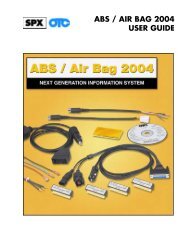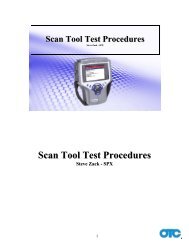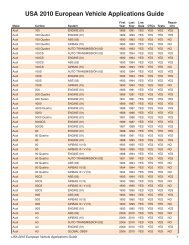Genisys User Guide - OTC
Genisys User Guide - OTC
Genisys User Guide - OTC
Create successful ePaper yourself
Turn your PDF publications into a flip-book with our unique Google optimized e-Paper software.
13: Special Tests<br />
Overview<br />
The Special Tests function lets you perform special<br />
bi-directional diagnostic tests on vehicle systems<br />
and components. The tests let you use the scan tool<br />
to activate or control the system components.<br />
NOTE: During a test, you use the tool to temporarily<br />
control a selected component. When you exit the test,<br />
the component returns to the normal setting.<br />
This chapter includes a basic procedure for doing the<br />
special tests, brief descriptions of the special tests,<br />
and examples of common special test screens.<br />
NOTE: While performing a special test, a Fault Code<br />
Detected screen may appear indicating a fault exists.<br />
Repair the problem and clear the diagnostic test code(s)<br />
before continuing the special test. For details about clearing<br />
codes, refer to Diagnostic Trouble Codes on page<br />
37.<br />
NOTE: The software has an automatic Diagnostic Code<br />
Triggered Record function. If a diagnostic fault occurs<br />
while you are testing a vehicle, the software automatically<br />
alerts you with a screen message and creates a recording<br />
for playback. To replay these recordings, refer to Playback<br />
on page 67.<br />
WARNING: Before performing any tests,<br />
refer to the Safety Precautions and instructions<br />
provided in this <strong>User</strong> <strong>Guide</strong> and the warnings<br />
provided by the vehicle manufacturer. In addition,<br />
follow any warnings and descriptions provided on the<br />
scan tool screens.<br />
WARNING: During active testing, bi-directional<br />
component activation is automatically “inhibited”<br />
when required to allow components adequate<br />
time to cool down. Do not bypass this cool-down<br />
period by restarting the test or by using any other<br />
means of bypassing the cool-down period.<br />
Basic Special Test Procedure<br />
The special tests vary for each vehicle, year, and<br />
module (Engine, Transmission, ABS, etc.). This<br />
section provides basic steps for the special tests.<br />
NOTE: The screens shown in this chapter are examples<br />
for the ABS module. Actual screens vary by vehicle and<br />
module.<br />
To perform special tests on a vehicle, follow<br />
these steps:<br />
1 Perform the steps in Test Startup and Vehicle<br />
Connection on page 14 to enter the vehicle information<br />
and display the Diagnostic Menu screen.<br />
2 From the Diagnostic Menu screen, select Special<br />
Tests. This displays the Special Tests menu screen<br />
(shown below).<br />
NOTE: If an identification screen appears, review<br />
the screen and press the ENTER key to display the<br />
Special Tests menu screen.<br />
Figure 13.1: Diagnostic Menu Screen and Special Tests Screen<br />
3 Select the test you want to perform and press the<br />
ENTER key.<br />
4 A group selection screen, test selection screen,<br />
several step-by-step instruction screens, or bidirectional<br />
control screen may appear. Read the<br />
screens and follow all instructions. If necessary,<br />
use the function keys to perform commands or<br />
answer any questions. Use the ENTER key as<br />
instructed. (See Special Test Screen Examples on<br />
page 64.)<br />
5 When finished, use the EXIT key to return to previous<br />
screens.<br />
Scan Tool <strong>User</strong> <strong>Guide</strong> 63






